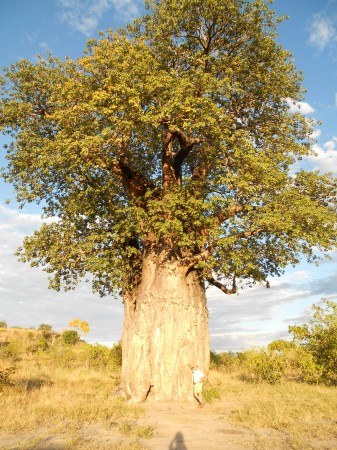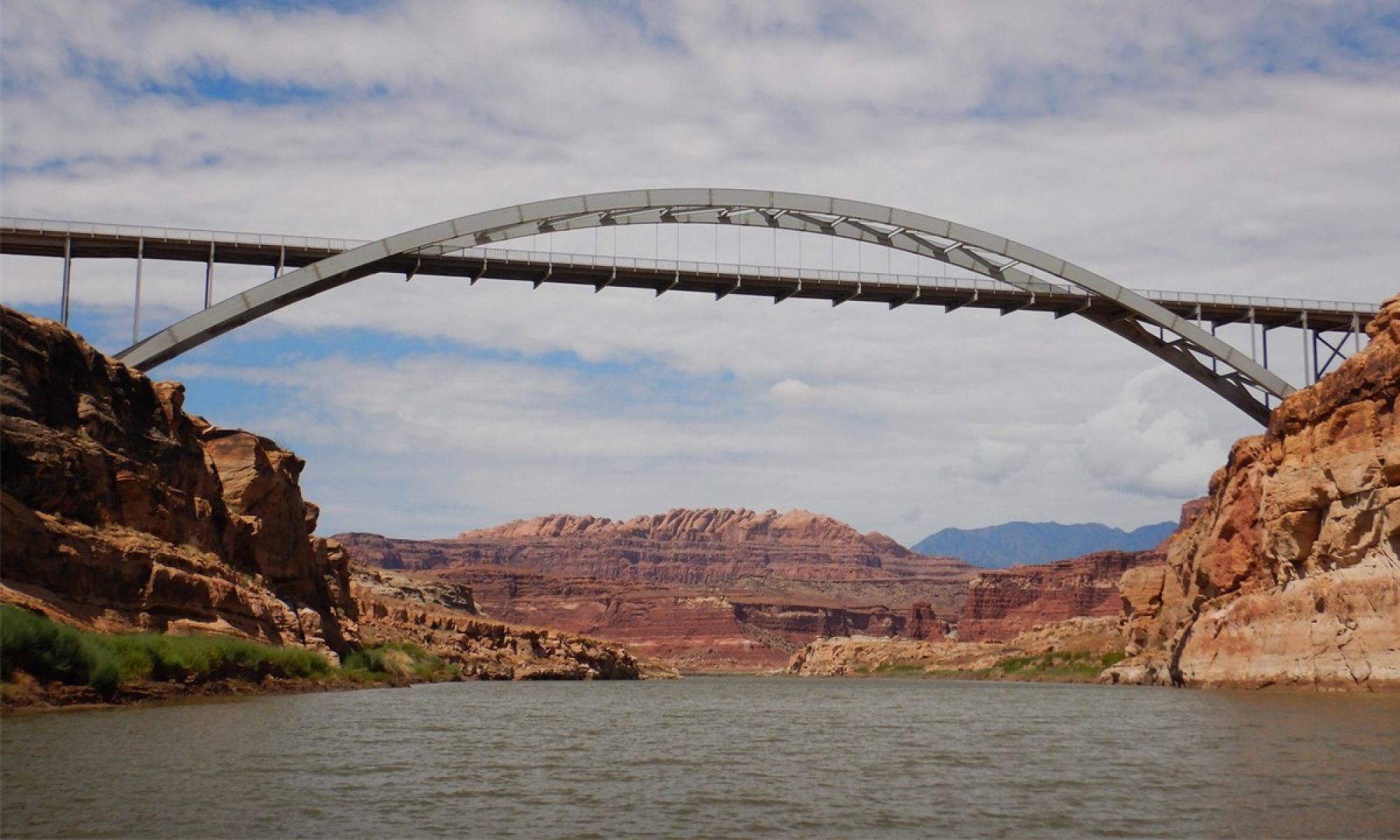April 4-10, 2012
We had a long holiday weekend over Easter so we decided to explore Botswana. Some of our friends had been to Botswana, and so we decided to learn more about this little-known country. The top three reasons commonly noted to go to Botswana are the Okavango Delta, big game and birding. Botswana is roughly the size of France or Texas with 18% of its area reserved for conservation. Botswana’s population is small, two million people. The Moremi Game Reserve is the first such reserve in southern Africa created by an African community on tribal lands. It is a major tourist draw and it has been very successful. The animals are thriving and reproducing. To get there, we flew from Johannesburg, South Africa to Maun Botswana, and then took a 6-seat plane for a 45-minute flight to an area almost inaccessible by road. All of our travel destinations within Botswana will have us fly either a large airbus 330-600 with South African air, a small BAe146 on Botswana Airlines or on a small Cessna, (both the red tail 8 seat and the blue belly 6 seat). The Moremi Game Reserve on the Okavanga Delta would be our first stop. We stayed at Camp Moremi on banks of the river’s main channel. The delta is formed by the Okavango River which descends from the Angolan highlands and fans out over western Botswana. The delta is an intricate network of channels and lagoons in a land locked country dependent on the rains and water of Angola covering 5,791 square miles. It is actually the world’s largest “bird-foot” delta that never reaches the sea, as the waters eventually descend into and under the Kalahari Desert.
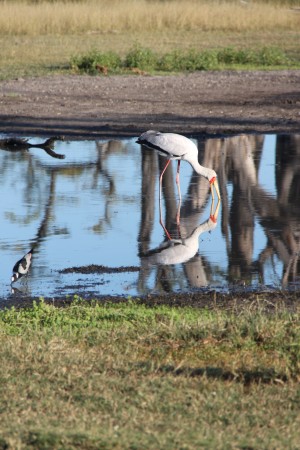
Camp Moremi is on the Xakanaxa lagoon in the heart of the Okavango delta and the Moremi Game Reserve. The reserve in his area is covered by Mopene forest, open grasslands, seasonal floodplains and Riverine habitats. The Moremi tree lodge is elevated amongst shady ebony trees and overlooks the lagoon. The camp only accommodates 22 people in safari tents on raised, teak decks.
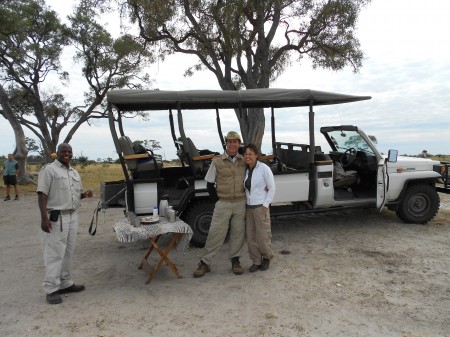
On arrival we were treated to a late lunch and the news that tea would be in 30 minutes followed by a game drive. Because it is winter (as of April 1st) the water has begun to flow at an increased rate into the delta from Angola. The entry drive into the camp itself is already covered in water 12-20 inches deep. We headed out to where a lion was last seen fairly close to the camp. Of course the lion did not know we were coming and had moved on. So we began tracking him deep into the grasses by following his footprints along sandy trails and roads, but never did find him. We did see impala, lechwe, roan and sable antelopes, warthogs, elephants and lots of birds! We found a hippo skull and heard about two hippos that recently fought nearby until one was fatally injured and died in camp. Of course, the staff could not leave a rotting hippo carcass in camp and had to use two land rovers to pull the multi-ton hippo away from the camp.
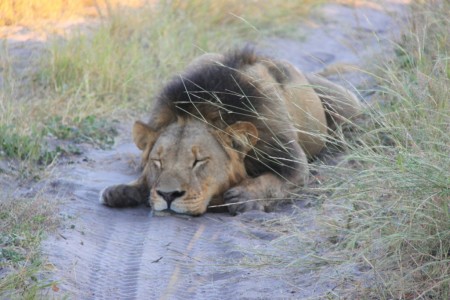
Eventually we heard from another passing guide that the lion were had been tracking was 20 feet from where we last tracked him and off we went to check. Sure enough, this lion was enjoying a lazy afternoon and barely gave us the time of day. We observed him from 15ft for awhile, and then left him snoozing and went to neutral ground for sundowners (G&T’s and local beef jerky). Upon return, dinner was by candlelight on the lodge deck overlooking the camp’s grounds and dock, followed by a nearby campfire. The staff joined us and the conversation was lively.
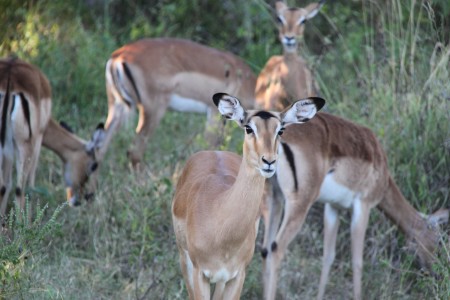
At 6am we heard the wakeup call, had a quick breakfast and went out on a morning game drive. We tracked lions, hippos and found an assortment of animals: baboons playing around elephants, impala, mongoose, monkey, hippo, waterbuck, crocodile and an eagle. We stopped for tea and biscuits out in the grassland but continued the drive until it was time for brunch. Brunch was just that breakfast and lunch…. too much food! Next decision: is it time for a siesta or a boat ride out on the delta? The delta won our ‘fancy’ and we took off to wander the delta via water by boat. The reeds and papyrus were higher than the boat, but the breeze was beautiful and we found hiding crocodiles, opening water lilies, growing water chestnuts and an elephant that traversed the delta’s channels to occupy a small island. There are 80 species of fish, along with crocodiles and otters co-existing in the waters of the delta.
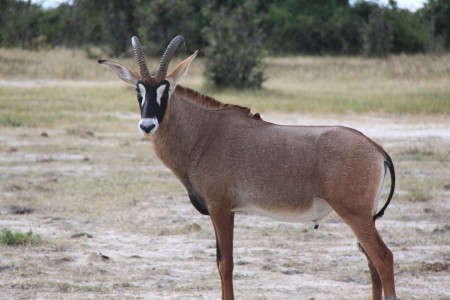
Then it was off to tea and our evening game drive. We drove a meandering route seeing elephants, impala, water buck and lechwe. Sundowners with nibbles ‘in-the-bush’ are always a treat. Dinner was guinea fowl and Kobe steaks. We stayed at the campfire for a short while but it was off to pack as we would leave the camp directly from the game drive after breakfast the next morning. Come dawn, we were up and at breakfast, and left our packed bags at camp as they would meet us at the airstrip.
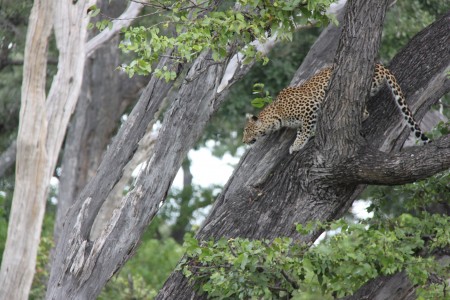
The game drive would be the most interesting, yet, as we headed to an island nearby via water covered roads. We saw an aging bull water buffalo, and impala. Then we found leopard tracks, lots of tracks! Lo and behold there was a leopard ahead in a tree. Under the tree were a group of impala. So this was obviously a hunting leopard. We witnessed the leopard watch the herd and then leave the tree to find a better vantage point by climbing another tree. At this place, there was a lone antelope which was unaware that the leopard was stalking him. It was captivating and tense to watch the leopard as it prepared to strike. She was so patient and still, crouched on the trunk of the tree with every muscle tensed ready to spring when her prey would get just 1 step closer! However, the antelope suddenly became aware of the leopard, leaped backwards and began “barking” to let the leopard and other animals know that the predator was spotted. Having lost her stealthy advantage, the leopard then settled into a comfortable tree branch for a nap and we left headed for the airstrip.
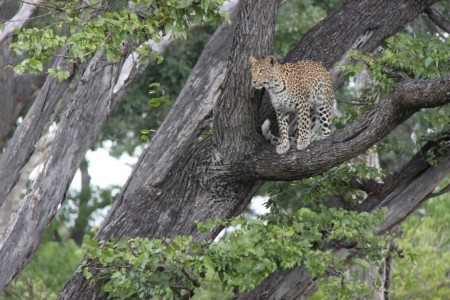
At the airstrip we met our pilot, a young lady named Vee from South Africa, and we were flying the blue belly Cessna for 30 minutes to Savute Safari Camp in Chobe National Park.
One hundred kilometers (62 miles) west of Victoria Falls, Zambia is Chobe National park, which is known for its elephants. The Chobe River is the center of this area which includes flood plains, dead lake beds, the pan, sand ridges and forest. At 4,500 square miles it is one of the largest parks in Africa. We are visiting the Savute area, which is dominated by the Kalahari and Mopene trees which the elephants love to eat. We are staying at the Savute safari lodge located upon the banks of the Savute channel. The camp is made up is 12 glass, wood and thatch safari suites overlooking the channel and a large watering hole.
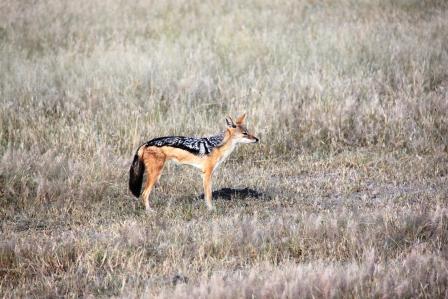
It is a 20 minute drive from the airstrip to camp. The roads are dry and 8-10 inches deep in sand – the sands of the Kalahari Desert. We spot giraffes, impala and wildebeest. We arrived in time for lunch on the deck in front of the water hole and the Savute channel. Our cabin is spectacular. The entire front wall is glass overlooking the channel and the water hole with massive sliding glass doors. What a view! We are watching elephants and antelope wander in and out of the stage in front of us, not more that 10 meters away. Luckily, the camp has a 12’-thick beam fence supported by electric wires to keep the elephants out, but other animal wander past us freely.
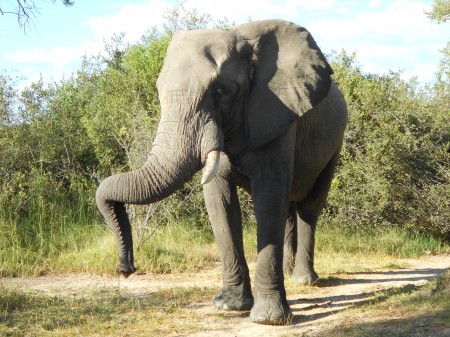
The camp routine is the same as at our previous camp, so at 3pm it is tea time followed by a game drive. We learned that a lion has been seen near a 40 year old elephant that has died a few days ago of natural causes. What we find are 2 lion brothers so sated from their afternoon feeding on the elephant that they are sacked out under the bushes. Given their laziness, we decided to move on; however, we encountered a large male hyena coming to visit the free meal. The hyena was tentative of us at first, but eventually decided to stroll past us on the way to the dead elephant. However, smelling the nearby lions, the hyena then moved off. The terrain here is very different than that of the Okavanga Delta. The area is full of Mopene trees that are stunted or stripped of their leaves due to their popularity with the elephants. The same goes for the Kalahari trees. There is also a large grove of 15 Ginko Biloba trees, each between 1000 and 1500 years old. This type of tree is the lone survivor of an ancient special, and one of the oldest living things on earth. After returning to camp we had dinner beside the water hole watching the elephants wander in and out. We had a night cap at the fire circle and had the chance to see a serval cat that appeared out of the undergrowth to explore the unattended coffee tray.
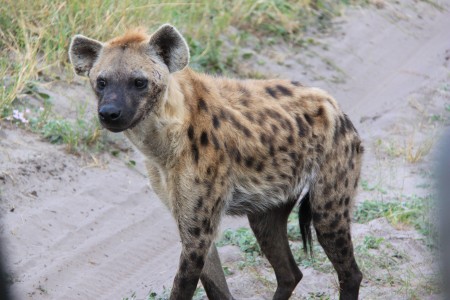
We woke the next morning to find leopard tracks at the side of our cabin. This explained the rustling and noise we heard during the night. The guide said that the leopard entered the camp hunting the guinea fowl which are plentiful in the area.
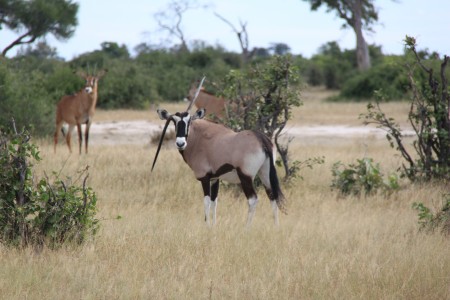
On our game drive that morning, we traversed huge plains of grasses, the local pan, and numerous water holes. However, it was quite hot (90 degrees F) for the beginning of winter…and the animals were scarce. We did see a couple of old elephant skeletons, which when you realize that there are 70,000 elephants in the area is not surprising.
It was Easter Sunday and the lodge had a lovely brunch including Easter eggs!
While the afternoon is free for siesta time…we enjoyed sitting on the deck and watching nature come visit our “private” watering hole….so relaxing.
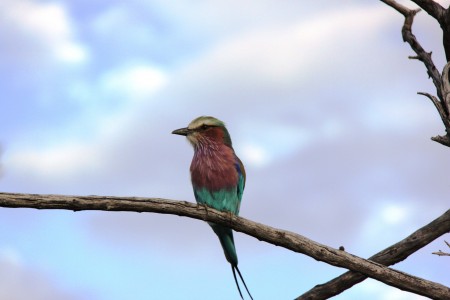
On this evening, the game drive was characterized by seeing small herds of animals, including wildebeests, impalas, and waterbuck. Again, after dinner we were privileged to see the serval cat which had visited us the night before. This serval cat had a long tale and beautiful colors, and allowed us to get some excellent pictures of him.
Sleep that night was interrupted by the lions calling again and again. There is a pride of five young brothers in the area, and the two which we saw the day before were in search of their ‘brothers’. We awoke for a quick breakfast and then were out the gate where there was numerous paw prints, both lion and leopard. We also saw the tracks of a leopard dragging an impala through the sands. However, despite our best tracking efforts we never did see this leopard. We decided to check out the area of the deceased elephant again, and sure enough, our driver found one of the male lion brothers resting at the side of the road. We stopped to watch him for nearly an hour before he tired of the growing crowd of onlookers and decided to move off into the bush for a daytime nap. On his way, he passed right beside the vehicle so close that we could have patted him on the head! But, he paid us no mind. We then traveled back towards the camp where w saw a line of breeding elephants marching along.
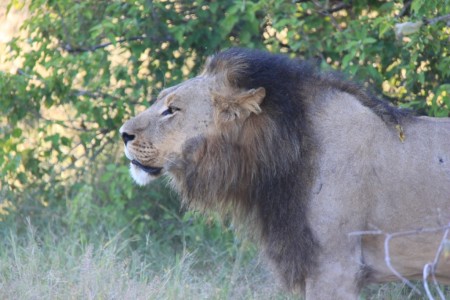
Our morning was cut short as we headed for the airstrip and the blue belly Cessna for a trip camp Moremi and then on to Maun. Once in Maun we are transported to the Cresti Hotel pool for drinks and relaxation as we await our next flight. At the pool side bar I met 2 young men from Zimbabwe. When they realized I was from the USA they proceeded to tell me about their adventure in Shreveport, Louisiana at the casino there. What a small world.
At 5 pm we boarded our flight to Johannesburg for an overnight stay at the Emperors Palace complex. We had a leisurely stroll and dinner at the huge Mall, and a peaceful night’s sleep. The next morning we returned to J’burg airport, shopped and headed back to Lagos. It was quite a whirlwind adventure, for just a long weekend. However, Botswana was a beautiful jewel snuggled in the middle of the southern continent, and we were glad we had the chance to visit it.
